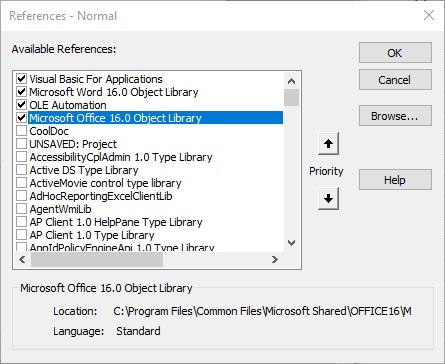Please Note: This article is written for users of the following Microsoft Word versions: 2007, 2010, 2013, 2016, 2019, and 2021. If you are using an earlier version (Word 2003 or earlier), this tip may not work for you. For a version of this tip written specifically for earlier versions of Word, click here: Using Call to Run VBA Macros.
Written by Allen Wyatt (last updated May 25, 2023)
This tip applies to Word 2007, 2010, 2013, 2016, 2019, and 2021
While it is possible to run a VBA macro from another macro by using the approach presented in the previous tip, there are times when such an approach just won't do the job. Instead, you need to look for a solution that allows a fail-safe method of running a macro. One approach is to use the Call command in VBA. Before you can use the command, however, you need to add a project reference to the calling project. (Projects are how VBA refers to the collection of VBA modules, forms, etc. in a template. For example, VBA refers to the Normal template as the "Normal" project.) References between projects provide an unambiguous defined link between a calling project and the project to be called.
For instance, let's say that the MyMacro macro (the one you wanted to run) was a part of the CoolDoc template. To use Call properly in VBA, you need to add a reference to the CoolDoc.dotm project to the macro that will call MyMacro. Unfortunately, this is a bit easier said than done because of a potential "gottcha" in VBA: Other than the "Normal" project, VBA gives all user-created template projects the default project name of "TemplateProject." This can create problems since having a unique project name is best when wishing to be specific about the macro to run. To give CoolDoc.dotm a unique project name, follow these steps:
If you expand all the objects under CoolDoc, you should see a module or two in the project. (Remember; VBA macros are contained in modules.) For the sake of this discussion, let's assume that MyMacro (the one you want to run) is contained within the HotStuff module of the CoolDoc project. (All these object names will be used shortly. At this point, you just need to note the names used for your project and the module with the macro.)
Now you are ready to actually add the CoolDoc project reference to the project from which the macro will be called. In this instance, let's assume you will be calling it from a macro in the Normal project. You can add the reference by following these steps (assuming that the VBA editor is still open):

Figure 1. The References dialog box.
Finally, you are ready to add the Call statement to the macro from which you want to call MyMacro. The command line would appear as follows:
Call CoolDoc.HotStuff.MyMacro
This command line causes VBA to run the desired macro, without any chance of ambiguity. There is something important to note, however. Putting a reference to the CoolDoc project in Normal makes Normal load a copy of CoolDoc every time Word is started—even if there are no documents open that are based on the CoolDoc.dotm template.
This loading of CoolDoc raises and obvious question: What is the point, in VBA, of putting MyMacro in CoolDoc.dotm since it won't save load time or resource usage? The short answer is that there isn't any point, other than CoolDoc.dotm possibly being a more obvious place to put code that only relates to things in CoolDoc.dotm. (This whole topic of sensible project design is far too big a subject to discuss in this single tip.)
Note:
WordTips is your source for cost-effective Microsoft Word training. (Microsoft Word is the most popular word processing software in the world.) This tip (11412) applies to Microsoft Word 2007, 2010, 2013, 2016, 2019, and 2021. You can find a version of this tip for the older menu interface of Word here: Using Call to Run VBA Macros.

Learning Made Easy! Quickly teach yourself how to format, publish, and share your content using Word 2021 or Microsoft 365. With Step by Step, you set the pace, building and practicing the skills you need, just when you need them! Check out Microsoft Word Step by Step today!
Want to know the absolute value of a number? It's easy to derive in VBA by using the Abs function.
Discover MoreWord allows you to create a macro that is run automatically whenever the program is started. If you want to bypass the ...
Discover MoreIf your documents include words that contain numbers (such as a list of parts numbers) you may need a way to increment ...
Discover MoreFREE SERVICE: Get tips like this every week in WordTips, a free productivity newsletter. Enter your address and click "Subscribe."
2023-08-16 16:58:00
Timothy Barton
Thanks for the advice. I'm looking to do this the other way round: I want a macro in a template to call a macro in normal.dotm.
If I run the main macro from normal.dotm, it works. An example of one of the lines is this:
------ Call FindReplaceAnywhere("Å", ChrW(448))
From what I've read, to run this line from a template, I'd change it to this:
------ Application.Run "Normal.FindReplace.FindReplaceAnywhere", "Å", ChrW(448))
But then I get run-time error 438: Object doesn't support this method or variable. Any idea why?
For what it's worth, the FindReplaceAnywhere macro is designed to take two arguments:
------ Public Sub FindReplaceAnywhere(pFindTxt As String, pReplaceTxt As String)
Got a version of Word that uses the ribbon interface (Word 2007 or later)? This site is for you! If you use an earlier version of Word, visit our WordTips site focusing on the menu interface.
Visit the WordTips channel on YouTube
FREE SERVICE: Get tips like this every week in WordTips, a free productivity newsletter. Enter your address and click "Subscribe."
Copyright © 2025 Sharon Parq Associates, Inc.
Comments